What should be the percentage of mid caps in your mutual fund portfolio: Analytical Perspective

In the previous part of this series, What should be the percentage of midcap mutual funds in your portfolio: Part 2, we discussed some common category allocations models used both in the US and in India. Small and midcap funds allocation in these models ranges from 20% to 50% depending on your risk tolerance levels. 20 to 50% is a fairly is wide range. So, what should your allocations to small and midcap funds be? Should it be towards the lower end of the range or the higher end of the range? Some asset allocation calculators use the investor’s age and investment horizon to profile their risk tolerance, but these calculators do not necessarily give the best results. Studies in the US have shown that investors have underinvested in small / midcap stocks and funds, and a result have lost out on a big chunk of returns that midcap stocks and funds delivered over the past many years. Do some of these category allocation models have a bias against small and midcap funds? In this blog post, we will not rely on heuristic models, but adopt a data driven statistical framework to explore, how small/midcap equity mutual funds in your portfolio affect the risk return characteristics of your portfolio. Hopefully, once you overlay your own investment objectives on the framework discussed in this article, you will be able to find the optimal portfolio mix of large cap and small/midcap equity mutual funds from a risk return perspective. Before we delve further, into the topic of this post, readers should note that:-
- In Advisorkhoj, we do not make a distinction between small cap funds and midcap funds, because many midcap funds have exposure to small cap stocks and small cap funds have midcap stocks. The small/midcap fund categorization in Advisorkhoj refers to all equity mutual funds, where the substantial portion of the portfolio is invested in small and midcap stocks.
- We are talking about large cap and midcap mutual funds, and not large cap and midcap stocks. The midcap and small cap segments comprises of a large number of stocks. Good mutual fund managers have the right kind of expertise and experience, to select the right small and midcap stocks, which have high potential, both from a value and growth perspectives.
- The risk / return figures that we will discuss in this blog post are category averages, or in other words the average risk or average return of all the funds in the category or categories that we are discussing. Individual funds may have different risk return characteristics.
- A statistical analysis or for that matter, any analysis, can never give a deterministic view of the future. If we had a definitive view on the future, I would not be writing this blog and you would not be reading it. In statistical analysis we talk about likely scenarios and probabilities associated thereof. While history has shown that, the probability of the likely scenario playing out in the future is reasonably high, there are times, when we get different results also.
Keeping the points mentioned above at the back of our minds, let us now deep dive into the historical returns and risk characteristics of large cap and small/midcap fund categories. The chart below shows the annual returns of large cap and small/midcap fund categories over the last 10 years.
Historical returns of Large cap versus Midcap Funds
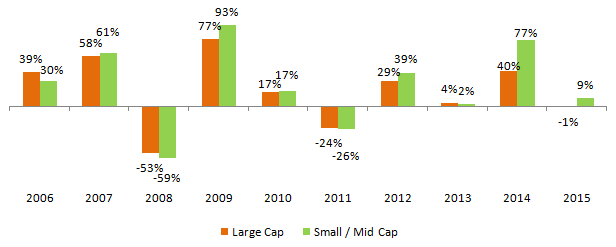
Source: Morningstar
You can see that, large cap funds outperformed small/midcap funds in some years and vice versa. But in most bull market years, you can see small/midcap funds outperforming large cap funds. Whereas in bear markets, you can see large cap funds outperforming small/midcap funds. 2015 was an exceptional year, where, despite a large correction, small/midcap funds outperformed large cap funds as a category.
So what does the graph above tells us? It tells us that, large cap and small/midcap funds perform better relative to each other in different market conditions, and therefore it makes sense to have both in your portfolio. But what should be the mix? For that we have to do some more analysis. If you follow our blog on a regular basis, you would know that, we do not believe annual returns or even trailing returns to be truly indicative of mutual fund’s performance. Annual returns tell us about the returns in a particular year. But we believe that, equity mutual funds should be held for a period of at least 3 years. Therefore 3 years annualized returns are more relevant for us, in this analysis. At the same time, trailing annualized returns are biased by the current market performance. We, in Advisorkhoj, believe that, rolling returns are the best measures of mutual fund performance. Rolling returns measures returns over a specific investment horizon, over all time periods in question. Therefore there is no bias. We have taken an investment horizon of three years, for purposes of this analysis. The chart below shows the 3 year annual rolling returns of large cap funds category versus midcap funds category.
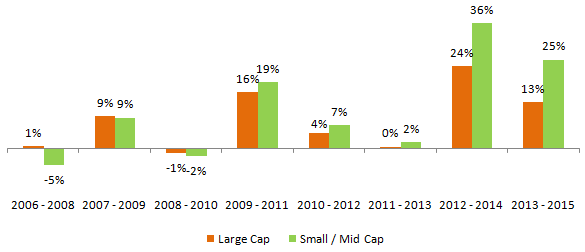
Source: Morningstar
Purely Large Cap Portfolio Returns
Let us now isolate large cap returns. The chart below shows the 3 years annual rolling returns if you portfolio comprised of large cap funds only (please remember, we are talking of average returns, not returns of top performing funds). The standard deviation of 3 years annual rolling returns of large cap funds is 8.8%. Standard deviation is a volatility or risk measure; we will re-visit this number later.
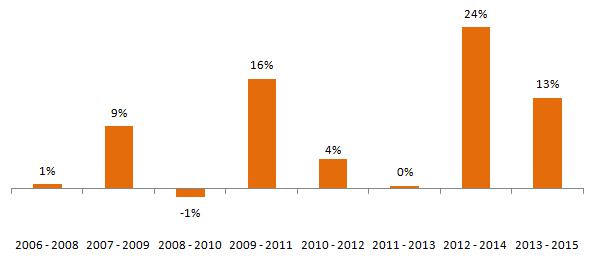
Source: Morningstar
80% Large Cap and 20% Small/Midcap Portfolio
Let us now compare the returns of a portfolio purely made up of large cap funds to a portfolio of 80% large cap funds and a 20% small/midcap funds.
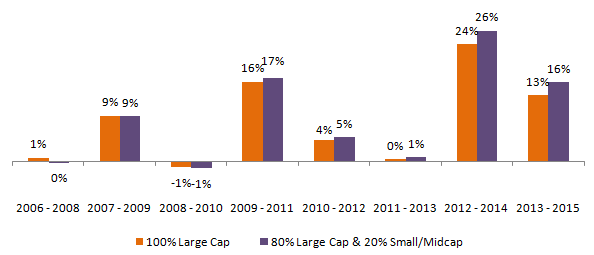
Source: Morningstar and Advisorkhoj Research
In the graph above, you can see that, the portfolio of 80% large cap and 20% Small/Midcap could have 2 – 3% higher returns compared to a portfolio of large cap funds and at the same time made 1% higher loss. Will you risk a 1% additional loss to get 2 – 3% additional profit? The decision is yours. But if you know, what the risk return trade-off is, then hopefully, you will be above to make the correct decision for yourself.
70% Large Cap and 30% Small/Midcap Portfolio
Let us now compare the returns of a portfolio made up of large cap funds only with a portfolio of 70% large cap funds and a 30% small/midcap funds.
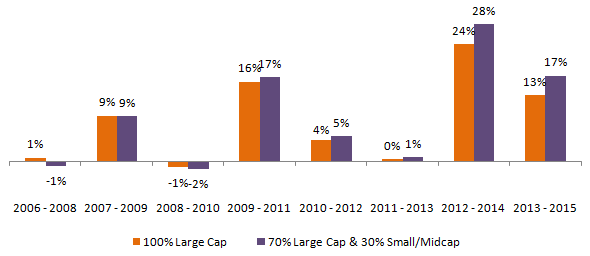
Source: Morningstar and Advisorkhoj Research
In the graph above, you can see that, the portfolio of 70% large cap and 30% Small/Midcap could have 4% higher returns compared to a portfolio of large cap funds and at the same time made 2% higher loss. As you can see the risk return trade-off improves as you add midcaps to your portfolio.
Different Portfolio Mixes
The table below compares the 3 year rolling returns of different large cap to small/midcap portfolio mixes with a portfolio of large cap funds.
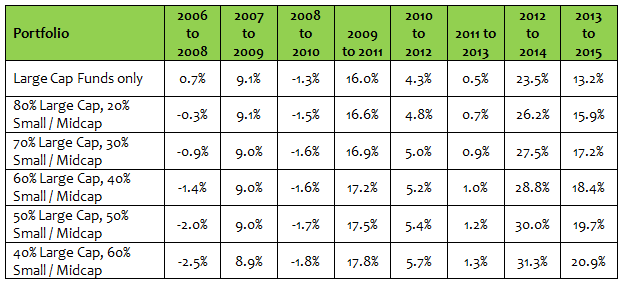
Source: Morningstar and Advisorkhoj Research
Readers who are familiar with the concept of risk and return know that, higher the risk, higher the return. However, the actual risk return characteristics of the different portfolio mixes in the table above are quite interesting. You can see that, for different portfolio mixes of large cap and midcap mutual funds, while the maximum reduction in returns by adding small / midcap funds to the portfolio is about 3%, the maximum gain in returns is about 7.7%. It seems that, the risk return trade off is favourable by having a higher percentage of small and midcap funds to the portfolio.
Standard Deviation as a measure risk
Let us now discuss a more sophisticated measure of risk in relation to higher returns obtained from small/midcap fund mix in the portfolio. Standard deviation of returns is a measure of portfolio risk. Let us see now, the standard deviation of different portfolio mixes.
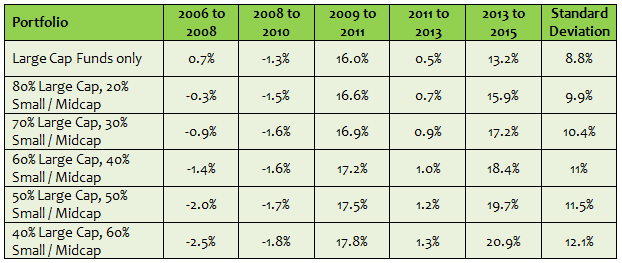
Source: Advisorkhoj Research
The standard deviation increases as we add small and midcap funds to the portfolio. This implies that the risk increases, as we add more small and midcap funds to the portfolio. But how do we interpret standard deviation? The standard deviation is difficult to comprehend in very simple practical terms and the standard percentage by itself, does not tell us much. But if we interpret standard deviation compared to average returns, in terms of areas under a normal distribution curve or bell curve, it can tell us a lot, with respect to probability of a loss, which at the end of the day, is what the investor should care about. We can estimate the different return possibilities in terms of average return and standard deviation from a normal distribution or bell curve, as shown below.
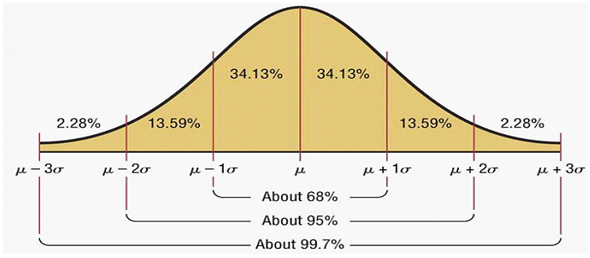
In the chart above, μ is nothing but the average returns and σ is the standard deviation (SD). The X-axis represents different return possibilities while the area under the curve, shows the probabilities of those returns. Based on this curve, if we know the average returns and the standard deviation, we can calculate the area of the curve to the left of the point, where the return (μ - Ζ σ) is zero.
Loss Probabilities of different portfolio mixes
Based on the rolling returns and standard deviation, we can estimate the probability of making a loss for different portfolio mixes, using normal distribution or the bell curve.
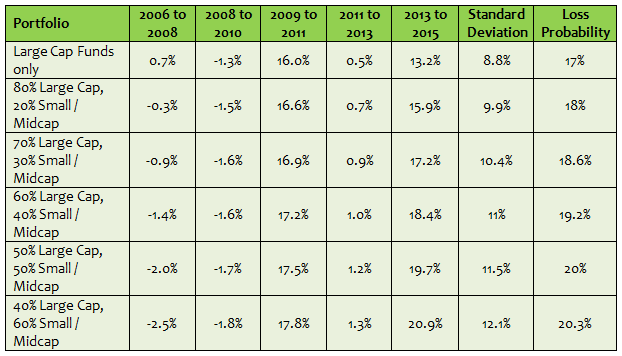
Source: Advisorkhoj Research
As you can see in the table above, as the probability of making a loss increases from 17% to 20.3%, the possibility of maximum returns, increases from 13.2% to 20.9%. The risk return trade off seems to become more favourable when we add small / midcap funds to the portfolio.
What should be the optimal portfolio mix?
The optimal portfolio mix is the one, which gives you the best risk return trade-off. To understand best risk return trade-off, you have to identify the level of risk that you are comfortable with. The notion of risk does not have to be ambiguous. You can quantify the notion of risk, in terms of probability of loss that you are ready to accept. If you ready to accept a 20% probability of loss, then 50 to 60% midcap funds and 40 – 50% large cap funds can give you best results. You can have an even higher allocation of small/midcap, if your risk appetite is higher and you understand your risk appetite, in terms of probability of losses. If you are ready to accept only 18% probability of loss, then 70 to 80% midcap funds and 30 – 40% large cap funds. What is the difference between 18% probability of loss and a 20% probability of loss? Frankly, not much, if you have a long investment horizon, with no immediate requirement of liquidity from your investments. On the other hand, lower returns, however unlikely, cause distress to you, if your financial goal is approaching. If you are approaching your goal and your portfolio loses 10% in value, it can take you many years to recover the loss. Therefore, you should re-balance your portfolio according to your situation.
Conclusion
In this blog post, we discussed the risk return characteristics of different portfolio mixes of large cap and small / midcap equity mutual funds. In the previous part of this series, What should be the percentage of midcap mutual funds in your portfolio: Part 2, we discussed some common models, for large cap to small/midcap mixes in your mutual fund portfolio. You can get good results from those models, but not necessarily the best results. The best results, as discussed in this post, depend on you. To get the best results, you do not have to depend on any model, but on your understanding of the risk return framework and your own risk capacity. Your own risk capacity does not need to be based on simply a conceptual understanding, but a crisp understanding of how much loss you are willing to take. As we have seen the probability of losses, does not change dramatically between an 80% large cap & 20% small/midcap portfolio and 40% large cap & 60% small/midcap portfolio, as long as you have a sufficiently long investment horizon, while the returns of these two portfolios can be significantly different. However, as we have discussed, risk becomes much more important than returns, when you approach your investment goals, or when you need income from your investments. Armed with the knowledge of risk return characteristics of large cap to small/midcap mix in your mutual fund portfolio, hopefully, you will be to make investment decisions that best meet your financial goals.
Recommended Reading: What should be the percentage of midcaps in your equity portfolio: Part 1
RECOMMENDED READS
Sundaram Asset Management Company is the investment manager to Sundaram Mutual Fund. Founded 1996, Sundaram Mutual is a fully owned subsidiary of one of India's oldest NBFCs - Sundaram Finance Limited.
Quick Links
- Interview - Mr. Dwijendra Srivastava - CIO - Fixed Income
- Interview - Mr. Sunil Subramaniam - CEO
- Sundaram Select Midcap Fund: Consistent outperformance makes it a big wealth creator
- Interview - Mr. Sunil Subramaniam - CEO
- Fund Manager Interview - Mr. Krishna Kumar - CIO - Equities
- Sundaram Rural India Fund: This thematic Mutual Fund aiming good long term returns
- Sundaram Equity Multiplier: Long term wealth creation potential
- Our Articles
- Our Website
- SIP one sheeter-Investor Education initiative
- Sundaram Asset Management Singapore
- Returns Calculator
- SEBI Investor Awareness Initiative
- Check your KYC Status
- KYC Forms & FAQs
- Recieve your PIN
- A note on NIGO
- FAQs on RGESS
- FAQs on Direct Plan
- Receive Updates
- Share your views
- Transmission Checklist
- Equity Application Form
- Fixed Income Application Form
- Transaction Slip
- Factsheet May - 2016
- MF Tax Reckoner 2015
Follow Sundaram MF
More About Sundaram MF
POST A QUERY




